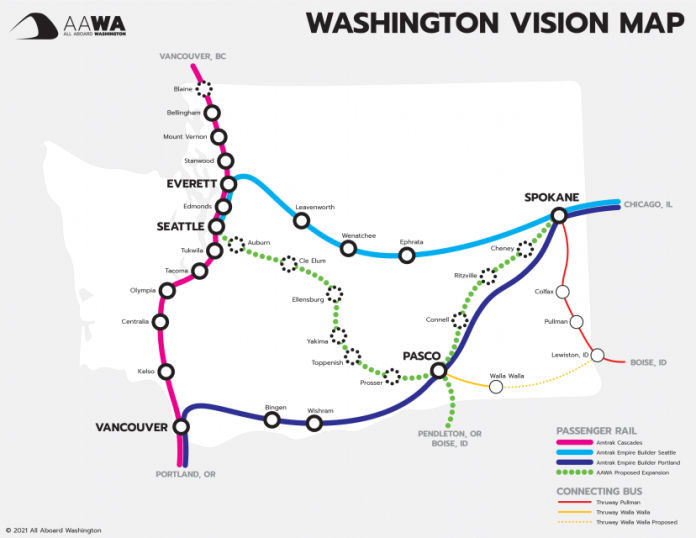“It’s not planning for today. This is a vision that’s planning for where the region is going to be in twenty years. If we don’t start now we’re never going to get there.” This is what Washington State Senator Marko Liias said of the proposed 2022 “Move Ahead Washington” transportation legislation package, which sets aside $150 million of state funding for the development of ultra-high-speed rail (UHSR) in Washington. All Aboard Washington is concerned that “Move Ahead Washington” does not anticipate leveraging the $66 billion in Federal funds for rail that the Bipartisan Infrastructure Law (BIL) provides. BIL funding will be essential to help achieve our state’s climate, traffic reduction, and transportation safety goals. ”Move Ahead Washington” only maintains the uninspiring status quo for the foreseeable future.
Expanding the Amtrak Cascades rail line is foundational to making ultra high speed rail (UHSR) a reality in the Pacific Northwest. As international best practice shows, intercity passenger rail services are essential to UHSR services. By upgrading existing infrastructure, we can quickly leverage prior investments in a cost-effective transportation service and organically grow our constituency of train riders who are more open to supporting long-term UHSR projects. This is why the original implementation plan for UHSR, codified by the 1993 Washington legislature in (HB 1617), emphasized the necessity to complete an initial rail corridor development plan as a way to foster ridership and support for trains in our region, in-line with international best practices. Amtrak Cascades was created because of this legislation, and so far has performed remarkably well with modest investment.
The current Amtrak Cascades train service, between Vancouver, B.C., and Eugene, OR, routinely drew 800,000 annual passengers out of the sky and off the roads pre-pandemic, while running less than half of the service that similar corridors do in California and on the East Coast. Presently, there are only three daily Amtrak Cascades round trips to Portland from Seattle. Officially, the legislature and DOT will grow this to six daily trips as we recover from the Pandemic. That is not enough. Six round trips is the exact level of service the corridors in California had in 1991; now the Capitol Corridor between the Bay Area and Sacramento, and the Pacific Surfliner between Los Angeles and San Diego, run all day, every hour. They draw millions of annual passengers. They are the foundation of California’s HSR project.
That means we are thirty years behind the curve with our own groundwork for UHSR — Amtrak Cascades needs to run more often and touch more of the state. Expansion of Amtrak type service from Seattle to Spokane via Yakima and the Tri-Cities is projected to perform competitively with other intercity passenger rail corridors with a similar frequency of service based on the July 2020 JTC directed study: Feasibility of an East-West Intercity Passenger Rail System for Washington State. The graphs below illustrate the projected ridership of East-West Cascades service in relation to other existing intercity services having frequencies of one and two round trips daily.
Governor Jay Inslee rightly recognized climate change as “the biggest threat currently facing Washington” in a recent speech at Gonzaga University. With less than 10 years to avert climate change’s worst effects, the timeliness of our response will make or break our success. While UHSR is more cost-effective and environmentally friendly than further highway expansion and satisfies a long-term need for better connecting the Pacific Northwest, UHSR will require 30+ years and tens of billions of dollars to achieve any benefit. Meanwhile, traditional intercity passenger rail services such as Amtrak Cascades can be improved and expanded within a relatively short time frame to provide monumental near-term economic, social, and climate benefits at a small fraction of the cost.
Washington State must identify rail project priorities and aggressively compete for the newly available Federal BIL funds so Amtrak Cascades can, after decades of insufficient investment, reach its full potential. Implementation details of this unprecedented BIL are still being developed. An important aspect of BIL implementation is the process of designating “intercity passenger rail corridors” (BIL §25101) by the Federal Railroad Administration. The importance is that designated intercity rail corridors will be the preferred candidates for Federal funding.
“Move Ahead Washington” plan allocates no state funding for traditional passenger rail to take advantage of Federal matching funds, nor for any conceivable new improvement in Cascades service. Rather, “Move Ahead Washington” provides $150 million exclusively for UHSR, ignoring international best practices and sound planning from 1993 which encouraged the creation of Cascades and East-West rail services as a firm foundation for future UHSR services.
Why is that so? The Washington State 2019 Rail Plan states:
“Further study is needed for the Legislature to determine if an east-west intercity service is warranted. A more up-to-date and in-depth study would provide insight into whether intercity passenger rail service would be beneficial and feasible. Preliminary studies like this are used by decision makers to provide insight into the potential direct and indirect effects the service would have for Washington.” (p. 84)
We now know, from the July 2020 Washington State Joint Transportation Committee (JTC)-directed study that East-West service via Stampede Pass is technically and operationally feasible. Our Legislature has wisely invested in passenger rail and positioned our state to obtain funds from the federal government over the past three decades with extremely successful outcomes. Now, unexplainably absent from the “Move Ahead Washington” legislation is any mention of follow-on work needed to determine the return on investment of East-West passenger rail service or any direction for continued investment in Amtrak Cascades.
The time has come to improve our existing North-South Amtrak Cascades service and provide similar benefits across Washington by establishing East-West passenger rail service. After decades of half measures, our federal government is rightfully stepping up to support an improved national passenger rail network. This dramatic investment will increase ridership and raise the standards of our passenger rail program to those that California and the Northeast Corridor states enjoy, and is necessary to foster the train-riding culture the Pacific Northwest needs for UHSR to succeed. Washington State is on the verge of missing this once-in-a-lifetime opportunity by neglecting to provide funding for existing passenger rail services in its own transportation package this year. The best thing that can be done to support UHSR is to follow the wisdom of RCW 47.70.79 and aggressively improve and expand Amtrak Cascades service in conjunction with UHSR planning.
Our Amtrak Cascades service could be enhanced to perform similarly to California’s Capitol Corridor and Pacific Surfliner services by offering frequent all day service, serving multimillion passenger ridership, substantially bolstering local economies, and minimizing carbon footprints across the entire Northwest. The federal government could potentially provide the majority of the funds needed to complete this vision within the timeline of the “Move Ahead Washington” proposed legislation, representing monumental benefits to the people of Washington. However, with no mention of intercity passenger rail in our state’s 16 year funding plan, asking for federal funds will be difficult to justify.
The Washington State Department of Transportation (WSDOT) has been instructed by the Legislature to develop a Service Development Plan (SDP) for the Amtrak Cascades. In order to best leverage its prior investments, our Legislature needs to ensure that the SDP includes service goals commensurate with those contained in the “Long-Range Plan for Amtrak Cascades” (2006):
- Seattle-Portland travel time of 2 hrs 30 min, with 14 daily round trips;
- Seattle-Vancouver, B.C. travel time of 2 hrs 45 min, with 4 daily round trips;
- All current station stops;
- Headways of up to 1 hour, on clock-face schedules; and
- Minimum service day 6 am until 8 pm first and last departures from endpoints.
An Amtrak Cascades service system design plan should be designed to achieve the benefits of similar successful programs in California, and of those presently being developed by the Commonwealth of Virginia. This is a reasonable, achievable, and thanks to the BIL, affordable expectation for our state. WSDOT must expedite completion of the SDP to position Washington State to acquire federal funding for rail improvements that will help meet our climate, traffic reduction, and transportation safety goals.
The 2022 Move Ahead Washington package should feature stronger measures to support our state’s passenger rail program, namely:
- Create an aggressive service development plan and leverage BIL funds to significantly expand service on the present Amtrak Cascades corridor beyond the six round trips funded today.
- Conduct further study of East-West passenger rail service as recommended in the 2020 JTC study, Feasibility of an East-West Intercity Passenger Rail System for Washington State.
- Respond to the Federal Railroad Administration’s (FRA’s) intercity rail corridor selection process by recommending that the route from Seattle to Spokane via Stampede Pass be designated as an intercity passenger rail corridor in accordance with BIL Section 25101.
- Create public feedback mechanisms for rail, transit, and active transportation users that inform the Washington State Transportation Commission (WSTC), WSDOT, and the Washington State Legislature.
Senator Liias and Governor Inslee are right that Washington needs to take action today. All Aboard Washington believes Amtrak Cascades would be an excellent use of our state’s resources to address many of our most pressing transportation issues. We hope that the Legislature will have the flexibility to use some allocated funding from “Move Ahead Washington” for intercity passenger rail purposes. We also encourage our elected officials to consider more robust financial and planning support for Amtrak Cascades, intercity and local transit services, and active transportation projects that support Washington’s efforts to improve regional equity, foster local economic development, and reduce the negative environmental impacts of our transportation system.
For over 40 years, member-supported All Aboard Washington (AAWA) has promoted better passenger and freight rail service in the Pacific Northwest. We champion safe, reliable, frequent, competitive, and convenient passenger rail services that meet the needs of all Washingtonians. We are especially active supporters of intercity passenger rail service and intermodal connections to local transit.


